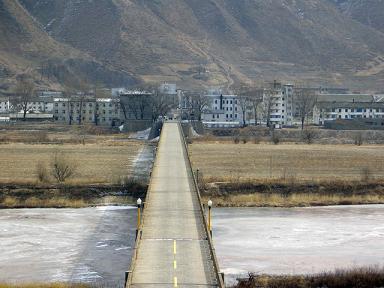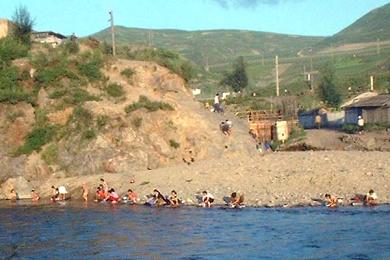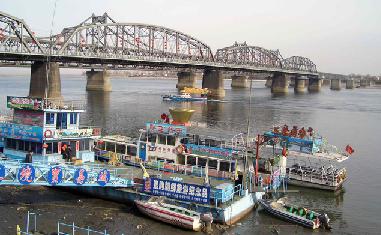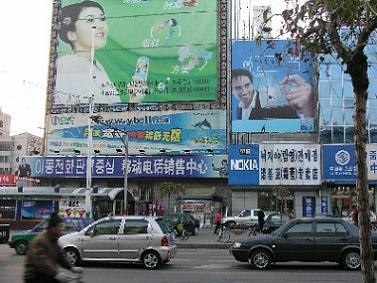공지사항
-
- '노란봉투'캠페인/국제연대..
- no chr.!
Last week(8.14) Asia Times published following report, written by A. Lenkov (just enjoy it!!):
Two countries, two systems, one porous border

The border between North Korea and China is more than 1,000 kilometers long. For most of its length the border goes along two rivers: the Tumen (Tuman in Korean pronunciation) and the Yalu (Amnok for the Koreans). Last month I made a trip along the border, and it was a very instructive undertaking indeed.

The border bridge between China and the DPRK (Tumen Riv.)
I was not alone. The borderland areas are popular with tourists, largely from South Korea. Chinese, usually from those parts of the country adjacent to Korea, come there too. Both Chinese and South Korean visitors love to ride boats that pass just a few meters from the North Korean shore, so people can throw cigarettes to North Korean patrols. Telescopes can also be rented for a few yuan to look across the river and get a glimpse at the neighbors.
It seems that Chinese often perceive these trips as a reminder that their country, in spite of manifold problems, is doing very well, and that there are places that look like a hell even compared with the provinces of northeastern China, which are relatively poor. Generally speaking, many Chinese see North Korea as a bizarre curiosity, a sort of living fossil reminiscent of China under Mao Zedong.
Actually, the borderland areas of both countries can be seen as relatively backward. For North Koreans, the far north of their country has always been the place of exile for people deemed politically unreliable. With the exception of some mines, Pyongyang did not invest much there, and it is no coincidence that the Great Famine of 1996-99 hit the area hardest; the authorities decided to sacrifice the local population as least useful and most expendable.
On the Chinese side, the borderland areas of Liaoning and Jilin provinces are also seen as underdeveloped - to an extent that this is seen as a political issue. However, it becomes clear from the first hours that the difference between what are considered poor regions might be as instructive as the difference between areas that embody success and prosperity.
The largest Chinese town on the Tumen River is small and sleepy Tumen, but this township presents a striking contrast with the impoverished lands across the border.

South (DPRK) of Tumen 'City' (China)..
However, a few decades ago, within living memory, the situation was the complete opposite. Until the early 1970s, North Korea was seen from China as a land of relative prosperity, so during the Chinese famine of the 1960s and the subsequent madness of the Cultural Revolution, ethnic Koreans from China often moved illegally across the border for the relative stability and affluence of Kim Il-sung's North Korea. There, at least, people were certain to receive 700 grams of corn every day.
Things have changed much since then: Deng Xiaoping's reforms in China launched an economic boom while North Korea stagnated and then began to slide backward, and by now the Chinese borderland areas have left North Korea far behind. Local Koreans who frequently visit their relatives on the other side of the border tell me that the situation in North Korea reminds them of China in the late 1960s, just after the failure of the Great Leap Forward.
Nowhere else is the difference as easy to see as in Dandong, a booming Chinese city just across from the North Korean city of Sinuiju. Dandong, with a population of some 2.4 million, is much larger than Sinuiju, which has 300,000 inhabitants. Dandong and Sinuiju are connected by a single bridge across the Yalu River sparsely used by both cars and trains. While more popular with tourists who like to go on it to snap pictures of North Korea, the bridge also serves as a transportation link between North Korea and outside world.

Dandong in China, just opposite of NK's Shinuiju..
Back in the 1970s, the two cities looked much the same, but now the difference is truly striking. The Dandong riverfront presents a spectacular picture of the post-socialist economic boom: highrise apartment complexes and office towers are being built everywhere, and a large river island is being turned into a resort development. The riverfront has been completely taken over by restaurants and hotels, as well as piers for small cruise boats (the thrill of going near the foreign shore seems to be irresistible to many Chinese).

Dandong, the bridge between the North and the South (NK)
However, the Korean riverbank is empty and bare, with only the roofs of few derelict buildings, three or four stories high, to be seen behind the trees. An abandoned Ferris wheel serves as a reminder that leisure activities can take place in North Korea, too. The Korean riverbank is also a resting place for few rusty boats that probably have not touched the water for years, but otherwise it is empty. There have been reports about some construction going on in Sinuiju. This indeed might be the case, but no traces of any economic activity can be seen from the Chinese side of the river.

The same in the night time.. (right China, left..^^)
This contrast becomes even greater at night. Compared with Beijing and Shanghai, Dandong is not brightly lit, but it still has its share of city lights. The other shore is in complete darkness, and only some distant lights hint at a place where the local statue of Kim Il-sung is located (the Dear Leader's statues are brightly lit until late evening). The bridge that connects two cities looks surreal: at night it appears as if it abruptly ends in the middle of the river, since the Chinese half is lavishly decorated with colored lights, while the North Korean half of the bridge is unseen in darkness. One can only wonder what the inhabitants of Sinuiju think when they look at the other side, seeing bright lights in night and mushrooming buildings at daytime. After all, most of the new apartment complexes in Dandong look luxurious even compared with the government quarters in Pyongyang, let alone the buildings in the city of Sinuiju.
So it comes as no surprise that many North Koreans illegally move across the border to find work and refuge in China. Around 1999, when the disastrous famine stuck North Korea, the number of such refugees reached an estimated 200,000-300,000. Nowadays, the number has shrunk considerably, even though old figures are often uncritically cited by the world media. It is believed that some 30,000-50,000 North Koreans are currently hiding in China.
Why did their numbers go down recently? There are few reasons for that. To start with, a remarkable improvement of the domestic situation in North Korea played a role, but most of people with whom I talked in China last month agreed that the major reason for this change is the revival of North Korean border security in recent few years. Until 2004 or so, North Korean authorities usually turned a blind eye to the mass exodus of their people to China. Perhaps they believed that the border acted as a security valve by letting some people out. It is also clear that at the height of famine and economic disruption, they had no resources to control the border at the necessary level.
It seems, however, that most policies are initiated by the North Korean authorities, not by their Chinese counterparts. For most of its length, the border is in essence unguarded on the Chinese side. There have been reports about Chinese patrols or even fences being erected in the area, but it seems that such measures are taken only occasionally and in some relatively small areas. I traveled 300km along the border, and only once saw a military patrol (four or five uniformed men were sitting in the shadows near a small truck, obviously having fun). Marked police cars were encountered four or five times, and no checkpoints were ever seen.
Local Koreans insist that the Chinese authorities generally ignore border issues. According to them, a North Korean refugee has some chance of being arrested only if he or she is unlucky or does not know how to keep a low profile, but the overall probability of arrest is not very high.
The physical obstacles for a trespasser are not too formidable either, since the border waterways are both shallow and narrow. The Yalu in its lower sections is broad, but the Tumen remains a narrow stream for nearly its entire length, and the upper parts of the Yalu do not form an impressive obstacle for any border-crosser. For most of the border's length, both waterways can be easily waded over in many spots even by old or infirm people.
This creates an ideal environment for smuggling. Indeed, the area is frequented by North Korean traders. Until a few years ago, most of them were illegal border-crossers. In most cases they did not try too hard to avoid detection, since bribing the border guards was a better strategy. North Korean guards are ready to receive 800 yuan (US$105), an equivalent of their annual salaries, from professional smugglers to allow them to move bulky merchandise almost openly.
However, since about 2003 some North Koreans have been allowed to apply for permission to visit China regularly and come back with merchandise. On the other hand, all ethnic-Korean residents in Yanbian autonomous prefecture, home to many of the Korean-Chinese in Jilin province, now can go to North Korea any time they wish. Ostensibly, the goal of such trips is to meet relatives on the other side of the border, but it is an open secret that nearly all trips are, first and foremost, trading expeditions.
Of course, customs officials expect their fair share of both legal fees and bribes. Corruption in North Korea is shocking even to Chinese visitors, who are not exactly used to a clean government.

Yanji..
A Korean-Chinese who occasionally goes to visit his relatives described his usual experience: "They are so greedy. Officials take bribes in China, too. But perhaps nowhere in the world are the officials so hungry for bribes as they are in North Korea. At customs, they slowly go through the luggage and sometimes put aside a few things they like, and then they say that those things are not allowed into North Korea. This is the hint, and I have no choice but to tell them to take those things, some clothing or small items. And it is a tradition that everybody who checks you should be given some foreign cigarettes. Last time I took five cartons of cigarettes with me, and only one carton reached my relatives. All others I had to give away to the officials."
A particular role is played by the chogyo, North Korean citizens who permanently reside in China. This is a relatively small group, some 5,000-10,000 people (well below 1% of the ethnic-Korean community in China), but their economic and social role is out of proportion to their numbers. Their unusual legal standing allows movement between China and North Korea almost at will, and this means that they have great opportunities for very profitable trade.
A similar group, known as hwagyo, consists of Chinese citizens who are allowed to live permanently in North Korea. Hwagyo is a Korean pronunciation of Chinese characters that are read as huaqiao in Mandarin and used to describe overseas Chinese. There are also only a few thousand hwagyo, and in North Korea they enjoy a number of privileges, including the right to go overseas with relative ease. Nowadays, as my interlocutors never failed to stress, the hwagyo have become the most prosperous social group in North Korea. Being a hwagyo means to be rich, and this wealth comes from involvement in lucrative cross-border trade, both legal and illegal.
In a shopping mall in Dandong, I came across a shop that bears the proud name of a "joint Korean-Chinese venture". This is an excessively grandiose name for a small operation jointly run by two women in their 50s. One of the two owners is a chogyo while another is a hwagyo. This makes a perfect partnership. They can go back and forth to North Korea, even visiting Pyongyang when necessary.
The shop trades in paintings by North Korean artists who are willing to sell their works very cheaply. The buyers are overwhelmingly South Koreans who are happy to pay for the North Korean exotics. The works might look kitschy, but there is no doubt that they were produced with remarkable technical skill. The entrepreneurial ladies visit major fine-arts academies and state-sponsored institutions in Pyongyang, placing orders there.
Next to their shop one can see a number of others, also run by North Korean petty capitalists (often with hwagyo or chogyo backgrounds), that also sell North Korean souvenirs to South Korean visitors. It is remarkable, however, that the topics are quite non-political. Only after some explicit demand can a sales clerk produce something more politically charged - say, a Kim Il-sung badge (probably not a real thing, but a Chinese imitation).
Both Dandong and Yanji have shops that specifically cater to the tastes and demands of North Korean merchants and visitors. Usually, such shops are clustered on the same street, creating a sort of North Korean market area. The shop signs tell what the North Korean wholesalers usually buy: household goods such as refrigerators or television sets, calculators, notebooks, pens and other stationery items, mechanics' tools, fans and telephones, as well as small power generators and batteries - in recent years a measure of self-reliance for power supplies has become an important sign of an affluent household in North Korea. They also sell fashionable clothing and footwear, often to be copied by North Korean manufacturers.
Another major item of the illegal trade is the videotapes and discs with foreign movies and shows that are increasingly popular in North Korea. The North Korean authorities try to restrict the inflow of foreign, especially South Korean, movies, but the profits are too high. The North Korean population wants entertainment, and has had enough of biopics depicting the great deeds of the Dear Leader, Great Leader and their august family. In most cases, entrepreneurs in China record the South Korean serials that are shown by the local TV networks almost daily, and then sell the recordings to the smugglers.
The border is also a major source of information for North Koreans. Since the 1960s, the North Korean authorities have exercised information control that is exceptional even by communist standards. North Koreans can go to prison if they are discovered to possess radios with unlocked tuning. All foreign publications (including those from "fraternal" communist regimes) are sent to the closed sections of the libraries, to be accessed only by the carefully selected owners of special permits, and even a trip outside one's native county is impossible without formal permission. Until recently, this system held, but changes in the borderland areas brought about a gradual disintegration of the North Korean information blockade.
Throughout the past decade, an estimated 500,000 North Koreans have been in China, overwhelmingly in the borderland regions, both legally and illegally. They have seen Chinese reforms, and they do not buy the official North Korean propaganda anymore. They are also skeptical about statements by Beijing ideologues who still describe China as a "socialist society". For them, modern China is an embodiment of capitalism, pure and simple, and also a demonstration of capitalism's efficiency and success.
A representative of a small non-governmental organization who has worked in the area for a decade told me how North Korean low-level officials typically react to China during their first visit: "They literally do not sleep their first night. They are overwhelmed by this prosperity, these lights, this abundance of food, this relaxed behavior of people." One has to keep in mind that this particular NGO operates in Tumen, a city that is clearly poor and underdeveloped by Chinese standards.
In many cases, North Koreans can see signs of Chinese success even without crossing the border. At nighttime, the bright sky over the Chinese towns is seen for dozens of kilometers, and in daytime one can easily see the many construction sites on the banks of the border rivers.
What is more important, the Chinese borderland serves as a conduit of information about South Korea. The South Korean presence in the area is remarkable, and at any given moment one out of 10 Korean-Chinese is in South Korea, working, studying or doing business there. Therefore, the border-crossers soon learn that South Korea, routinely depicted in the official Northern media as a living hell, is actually richer than China, which looks to them like a perfect paradise. They sometimes buy and secretly watch "subversive" South Korean movies and shows that are frequently broadcast by the local Chinese stations. This new information is penetrating the North, and recently it has become clear that even the notoriously shameless and inflexible North Korean propaganda machine has had to change its tune somewhat to adjust to this new knowledge.
The border is not really sealed anymore. The difference in living standards is large and growing, and this can be easily seen. We can only surmise when the effects of this new situation will be felt, but there are good reasons to believe that the borderland areas will play a major role in the future of what is now known as the Democratic People's Republic of Korea.
http://www.atimes.com/atimes/China/IH14Ad01.html
Related article:
☞ The gentle decline of the 'Third Korea'
최근 덧글 목록